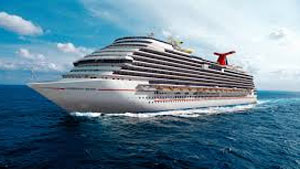 WASHINGTON, DC, USA (CMC) — The United States Department of Justice (DOJ) says a Caribbean cruise line has agreed to plead guilty to seven felony charges stemming from its deliberate pollution of the seas and intentional acts to cover it up.
WASHINGTON, DC, USA (CMC) — The United States Department of Justice (DOJ) says a Caribbean cruise line has agreed to plead guilty to seven felony charges stemming from its deliberate pollution of the seas and intentional acts to cover it up.
The DOJ said Princess Cruise Lines Ltd will pay a US$40-million penalty – the largest-ever criminal penalty involving deliberate vessel pollution – and plead guilty to charges related to illegal dumping of oil contaminated waste from the Caribbean Princess cruise ship.
The plea agreement was announced last Thursday by Assistant Attorney General John C Cruden for the DOJ’s Environment and Natural Resources Division and US Attorney Wifredo A Ferrer for the Southern District of Florida in Miami, Florida.
Princess, headquartered in Santa Clarita, California, is a subsidiary of Carnival Corporation (Carnival), which owns and operates multiple cruise lines and collectively comprises the world’s largest cruise company. Carnival is headquartered in Miami.
As part of the plea agreement with Princess, cruise ships from eight Carnival cruise line companies (Carnival Cruise Line, Holland America Line NV, Seabourn Cruise Line Ltd and AIDA Cruises) will be under a court-supervised Environmental Compliance Program (ECP) for five years, the DOJ said.
The ECP will require independent audits by an outside entity and a court-appointed monitor.
The charges to which Princess will plead guilty concern the Caribbean Princess cruise ship which visited various US ports in Florida, Maine, Massachusetts, New Jersey, New York, Puerto Rico, Rhode Island, South Carolina, Texas, US Virgin Islands and Virginia.
The investigation was initiated after information was provided to the US Coast Guard by the British Maritime and Coastguard Agency (MCA) indicating that a newly hired engineer on the Caribbean Princess reported that a so-called “magic pipe” had been used on August 23, 2013, to illegally discharge oily waste off the coast of England.
It’s reported that the whistle-blowing engineer quit his position when the ship reached Southampton, England.
It was also reported that chief engineer and senior first engineer ordered a cover-up, including removal of the magic pipe and directing subordinates to lie.
The MCA shared evidence with the US Coast Guard, including before and after photos of the bypass used to make the discharge and showing its disappearance, the DOJ said.
It said the US Coast Guard conducted an examination of the Caribbean Princess on its arrival in New York City, on September 14, 2013, “during which certain crew members continued to lie in accordance with orders they had received from Princess employees”.
According to papers filed in court, the Caribbean Princess had been making illegal discharges through bypass equipment since 2005, one year after the ship began operations.
The discharge on August 26, 2013, involved about 4,227 gallons, 23 miles off the coast of England within the country’s Exclusive Economic Zone, the DOJ said.
At the same time as the discharge, it said engineers simultaneously ran clean seawater through the ship’s overboard equipment in order to create a false digital record for a legitimate discharge.
The DOJ said Caribbean Princess used multiple methods over the course of time to pollute the seas.
Prior to the installation of the bypass pipe used to make the discharge off the coast of England, it said a different unauthorised valve was used.
When the Department of Justice investigative team conducted a consensual boarding of the ship in Houston, Texas, on March 8, 2014, the DOJ said they found the valve that crew members had described. When it was removed by Princess at the department’s request, it was found to contain black oil, the DOJ said.
In addition to the use of a magic pipe to circumvent the oily water separator and oil content monitor required pollution prevention equipment, the DOJ said the US investigation uncovered two other illegal practices, “which were found to have taken place on the Caribbean Princess, as well as four other Princess ships – Star Princess, Grand Princess, Coral Princess and Golden Princess”.
The DOJ said one practice was to open a saltwater valve when bilge waste was being processed by the oily water separator and oil content monitor.
It said the purpose was to prevent the oil content monitor from otherwise alarming and stopping the overboard discharge.
This was done routinely on the Caribbean Princess in 2012 and 2013, the DOJ said.
It said the second practice involved discharges of oily bilge water originating from the overflow of graywater tanks into the machinery space bilges.
The DOJ said this waste was pumped back into the graywater system rather than being processed as oily bilge waste.
In addition to the criminal information, the DOJ said a plea agreement and joint factual statement were filed in court in Miami.
Photographs of some of the evidence provided by the whistleblower and obtained by the government were also filed in US federal court, the DOJ said.
According to papers filed in court, Princess has undertaken remedial measures in response to the US government’s investigation, including upgrading the oily water separators and oil content monitors on every ship in its fleet and instituting many new policies, the DOJ said.
If approved by the court, the DOJ said US$10 million of the US$40-million criminal penalty will be devoted to community service projects to benefit the maritime environment; US$3 million of the community service payments will go to environmental projects in South Florida; and US$1 million will be earmarked for projects to benefit the marine environment in United Kingdom waters.
